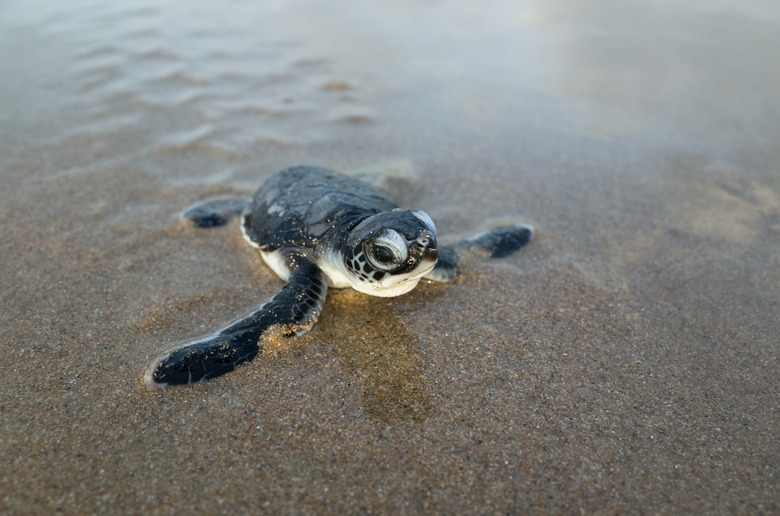Types Of North Carolina Turtles
You'll find turtles all across North Carolina, from the mountains to the coast; they've adapted to a vast spread of aquatic habitats, including marshes and ponds, large rivers and the marine realm of the state's bays and offshore waters. An impressive 21 species call North Carolina home, among them the largest turtle in the world. Some of these North Carolina turtles remain common and widespread; others fall on the threatened and endangered list.
NC Turtles Identification: Cheloniidae Family
NC Turtles Identification: Cheloniidae Family
There are four different types of turtles among the Cheloniidae . These include the loggerhead turtle, the green turtle, the Atlantic hawksbill turtle and the Atlantic (or Kemp's) ridley turtle. All four of these are sea turtles adapted to saltwater environments and an almost exclusively aquatic existence (except for females coming ashore to lay eggs). Two are threatened: the loggerhead, known for its heavy jaws, and the green turtle, which migrates long distances. Both the hawksbill – named for its beak-like mouth and hunted for its shell – and Atlantic ridley turtle are endangered; the latter species, in fact, ranks as the most endangered sea turtle in the world.
Leatherback, Snapping and Spiny Soft-shell Turtles
Leatherback, Snapping and Spiny Soft-shell Turtles
The leatherback turtle – the fifth species of sea turtle native to North Carolina and the largest turtle in the world – can grow past five feet long and weigh more than half a ton. Its shell is not hard like that of other turtles, a quality that explains its "leatherback" name. Snapping turtles are a very common freshwater species. Two subspecies of spiny soft-shell turtle live in North Carolina: the Gulf Coast and the eastern spiny softshell.
Spotted, Painted and Chicken Turtle
Spotted, Painted and Chicken Turtle
The spotted turtle is can be found in eastern North Carolina. Its shell is very dark, with yellow spots. Many people collect spotted turtles for pets, which has put them on the threatened species list. The painted turtle gets its name from the distinctive red, yellow and black colors on its shell. Painted turtles are the only reptiles besides the diamondback turtle that will freeze during the winter and thaw in the spring. Chicken turtles can be identified by the horizontal and vertical stripes on their limbs.
Bog, Yellowbelly Slider and Diamondback Terrapin Turtles
Bog, Yellowbelly Slider and Diamondback Terrapin Turtles
The bog turtle is found in western North Carolina. It prefers wetland areas in the mountains, and usually buries itself in the mud. The yellowbelly slider is easily identified by its bright yellow belly. It inhabits the eastern half of the state and commonly shows up as an aquarium pet. Diamondback terrapin turtles are mainly found in coastal wetlands and creeks , being most widespread in brackish waters: in other words, those with a mix of fresh and saltwater.
River Cooter, Florida Cooter and Redbelly Turtle
River Cooter, Florida Cooter and Redbelly Turtle
The river cooter turtle is found in the eastern half of North Carolina. The most common way to tell the river cooter apart from its relative the Florida cooter – also a resident of eastern North Carolina – is habitat: The river cooter prefers rivers and streams, while the Florida cooter prefers lakes and marshes. The redbelly turtle is only found in the northeastern corner of the state, mainly in still or slow-moving bodies of water. The redbelly, river cooter and Florida cooter are all known to interbreed.
Eastern Box Turtle, Striped and Eastern Mud Turtle
Eastern Box Turtle, Striped and Eastern Mud Turtle
The eastern box turtle is a very colorful turtle found across North Carolina. It will eat almost anything it can. Box turtles prefer forested habitats. The striped mud turtle is found in the eastern half on the state. These turtles are very small: only three to four inches long. Eastern mud turtles are not good swimmers. They are found in most of North Carolina, except the western half of the state, and are sometimes mistaken for snapping turtles.
Stripeneck Muck Turtle and Common Musk Turtle
Stripeneck Muck Turtle and Common Musk Turtle
The stripeneck musk turtle is not very widespread in North Carolina, found only along the northwestern border of the state in two counties. It resides primarily in rivers and streams. The common musk turtle, in contrast, can be found all across North Carolina. It gets its nickname of "stinkpot" because it secretes a musky smell from its anal glands if it is threatened. This turtle may also bite when picked up.
Cite This Article
MLA
Winnick, Caroline. "Types Of North Carolina Turtles" sciencing.com, https://www.sciencing.com/types-north-carolina-turtles-8214517/. 22 November 2019.
APA
Winnick, Caroline. (2019, November 22). Types Of North Carolina Turtles. sciencing.com. Retrieved from https://www.sciencing.com/types-north-carolina-turtles-8214517/
Chicago
Winnick, Caroline. Types Of North Carolina Turtles last modified August 30, 2022. https://www.sciencing.com/types-north-carolina-turtles-8214517/
